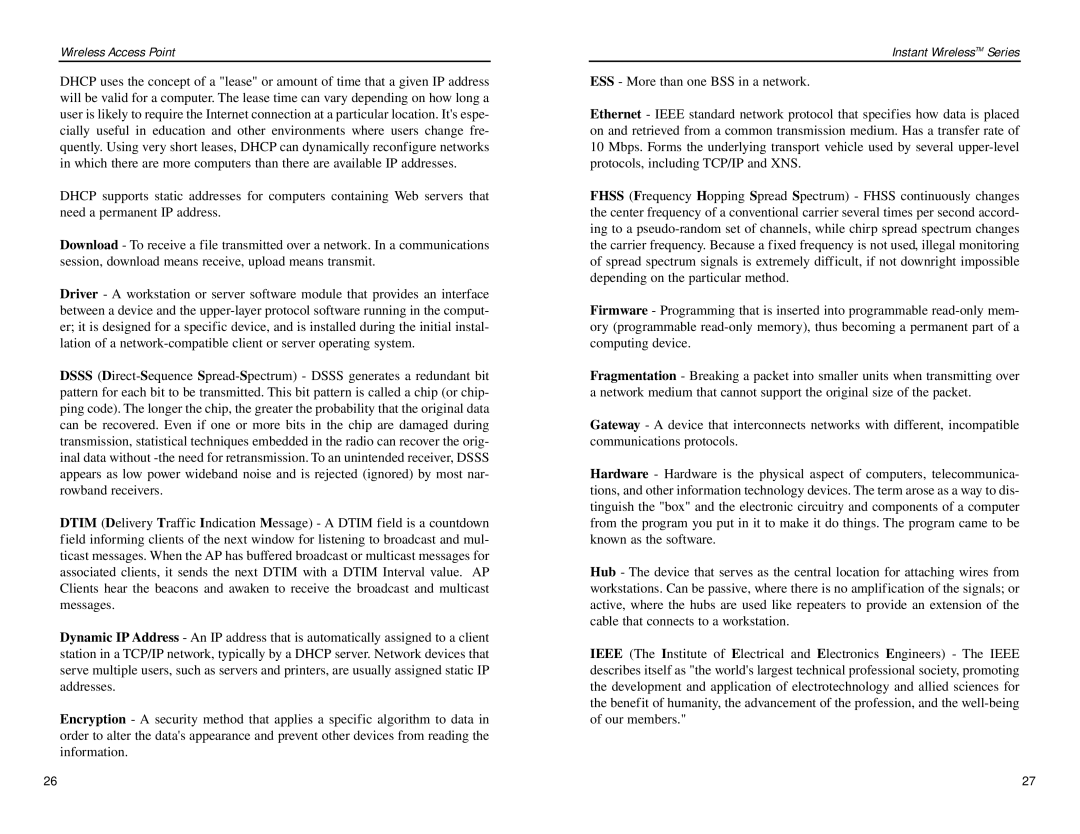Wireless Access Point
DHCP uses the concept of a "lease" or amount of time that a given IP address will be valid for a computer. The lease time can vary depending on how long a user is likely to require the Internet connection at a particular location. It's espe- cially useful in education and other environments where users change fre- quently. Using very short leases, DHCP can dynamically reconfigure networks in which there are more computers than there are available IP addresses.
DHCP supports static addresses for computers containing Web servers that need a permanent IP address.
Download - To receive a file transmitted over a network. In a communications session, download means receive, upload means transmit.
Driver - A workstation or server software module that provides an interface between a device and the
DSSS
DTIM (Delivery Traffic Indication Message) - A DTIM field is a countdown field informing clients of the next window for listening to broadcast and mul- ticast messages. When the AP has buffered broadcast or multicast messages for associated clients, it sends the next DTIM with a DTIM Interval value. AP Clients hear the beacons and awaken to receive the broadcast and multicast messages.
Dynamic IP Address - An IP address that is automatically assigned to a client station in a TCP/IP network, typically by a DHCP server. Network devices that serve multiple users, such as servers and printers, are usually assigned static IP addresses.
Encryption - A security method that applies a specific algorithm to data in order to alter the data's appearance and prevent other devices from reading the information.
Instant WirelessTM Series
ESS - More than one BSS in a network.
Ethernet - IEEE standard network protocol that specifies how data is placed on and retrieved from a common transmission medium. Has a transfer rate of 10 Mbps. Forms the underlying transport vehicle used by several
FHSS (Frequency Hopping Spread Spectrum) - FHSS continuously changes the center frequency of a conventional carrier several times per second accord- ing to a
Firmware - Programming that is inserted into programmable
Fragmentation - Breaking a packet into smaller units when transmitting over a network medium that cannot support the original size of the packet.
Gateway - A device that interconnects networks with different, incompatible communications protocols.
Hardware - Hardware is the physical aspect of computers, telecommunica- tions, and other information technology devices. The term arose as a way to dis- tinguish the "box" and the electronic circuitry and components of a computer from the program you put in it to make it do things. The program came to be known as the software.
Hub - The device that serves as the central location for attaching wires from workstations. Can be passive, where there is no amplification of the signals; or active, where the hubs are used like repeaters to provide an extension of the cable that connects to a workstation.
IEEE (The Institute of Electrical and Electronics Engineers) - The IEEE describes itself as "the world's largest technical professional society, promoting the development and application of electrotechnology and allied sciences for the benefit of humanity, the advancement of the profession, and the
26 | 27 |
